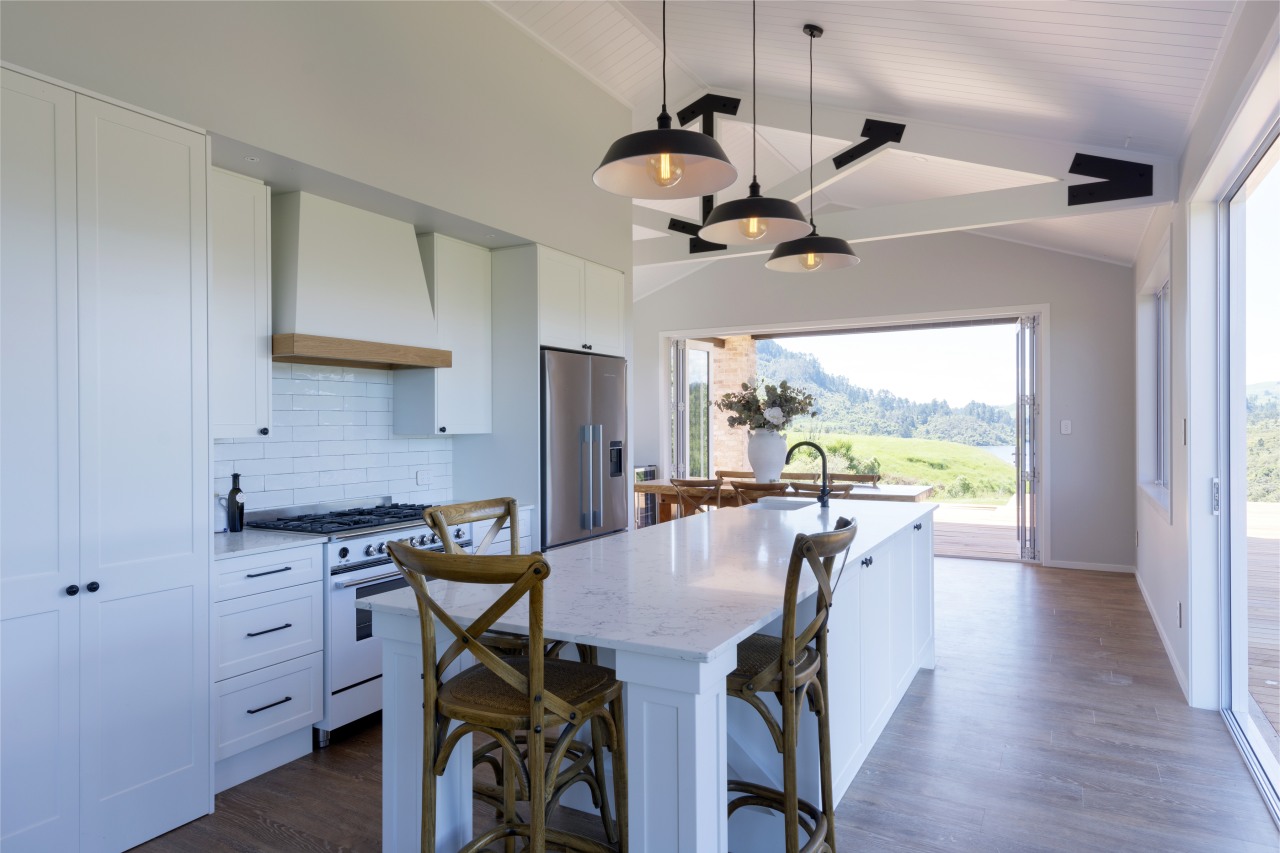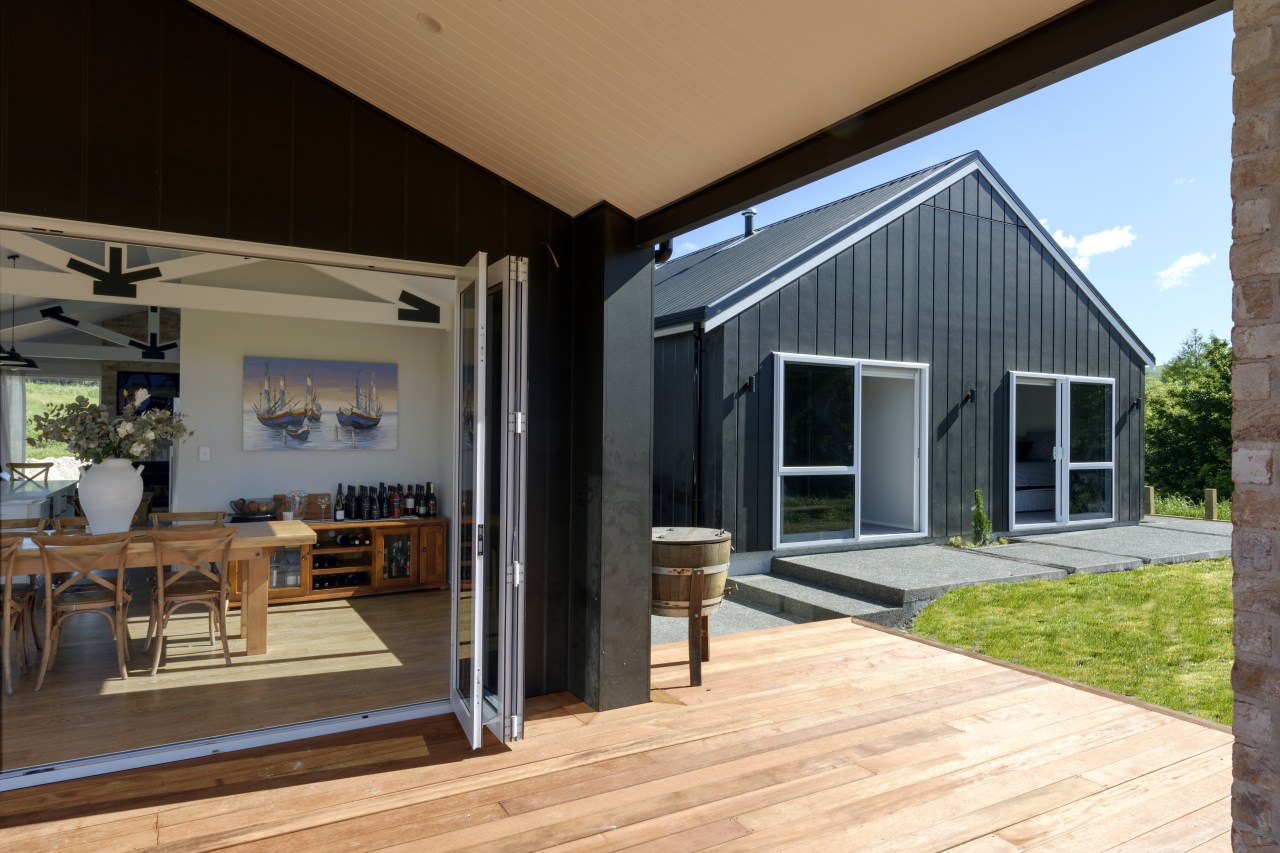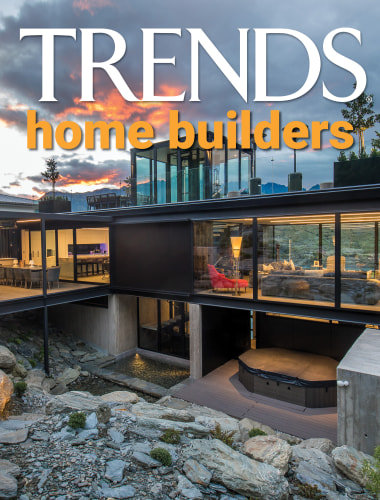A river runs past it
This idyllically situated home reflects a French Country appeal dovetailed with industrial touches – David Reid Homes translated the owners' dreams into their dream home
A river runs past it, or is it a lake?
You could name it the Waikato River or Lake Ohakuri and neither would be wrong, says one owner, who was drawn to live here on the site of a former wakeboard camp by her then-fiancé.
He had bought the land while working in Australia as a fly-in electrician on the mines and his proposal to relocate to this rural block in Reporoa meant she had to give up her job as a graphic designer and retrain.
The couple soon set up their own electrical business and she is one of few women in New Zealand qualified as an instrument technician.
That was some time before this modern farmhouse was built beside the water.
For three years, they had occupied a renovated shed on the nine-hectare property – it wasn’t exactly roughing it, but they dreamed of their first real home.
With practical nous and definite ideas about design, they considered taking on the entire project themselves.
“We ummed and ahhed for ages but realised that with our hectic jobs travelling all over the country, we just didn’t have the time,” they say.
The location deserved a bespoke approach and, when David Reid Homes gave them carte blanche with the design and would guide and project manage the job from go to whoa, they knew they had found their fit.
Stress free choices
First, the pair worked with their architect on the orientation of the home, which may seem obvious now but at the time was a real conundrum.
The challenge was how to capture the view from every window without having to hang the building over the edge?
Regulations meant they needed to remain 10m from the riverbank and building up a hillside of terraces was the solution.
This poser sorted, they moved on to the aesthetics, sending in photos of buildings and materials they liked to evolve the design.
“It was stress free in terms of figuring those things out,” they say.
Navigating the consenting issues (of which there were a few) was more tedious but the couple gave the paperwork over to the David Reid team while they focussed on the finish line.
They moved in just after the first lockdown.
Put simply, the house comprises two offset pavilions linked by a hallway.
The bedroom pavilion, which includes an office, is set back while the living zone pavilion pushes forward to follow the course of the river.
The gabled forms, clad in low-maintenance black Linea weatherboard, have their roots in the agricultural building typology.
“We wanted the white-trim windows because that is more traditional for a barn."
One more material – reclaimed brick – has been used to good effect on the chimney and as a feature wall along the hallway.
It’s an element that gives some heft to the palette and, somewhat to her surprise, works in beautifully.
French Country meets industrial chic
“As far as style goes, I like old-fashioned French Country; his taste is for hard-industrial, so the brick and exposed beams are things he wanted,” she says.
The interiors are a fusion of both looks, particularly in the living zone.
Unusually, this young couple did not opt for the on-point black-on-black aesthetic but went for something more welcoming.
They located the kitchen right in the middle of the floorplan, close to the covered patio.
It’s not that they’re always entertaining, more like surrendering their kitchen to all comers.
“Our house is like a revolving door with people coming and going all the time – it’s pretty rare that we're here just on our own."
White cabinetry with a picture-frame profile channels a modern-country style; there are engineered-stone benchtops that look like classic marble and a magnificent double oven in white that could feed the thousands.
Industrial metal pendants above the island and exposed trusses in white but with black-metal brackets hang from ceilings lined in grooved weatherboard to bring texture to the lofty room.
Warmth and comfort
To keep costs reasonable, to limit damage by Frankie (a labradoodle with attitude) and their pet goat who wanders in if opportunity arises, but mainly to make the most of the underfloor heating, the couple opted for laminate flooring that looks like aged American oak.
The whole house is geothermally heated from an on-site bore.
This means they seldom need to light the fire, except to enhance the ambience for moments of relaxed homeliness.
Warmth and comfort were at the top of the priority list so chunky, rustic touches were on order.
One of the owners' dads turned his hand to making the vanity top in the main suite bathroom from a huge slab of macrocarpa and the dining table, polished to a lovely sheen, is also crafted by this accomplished hobby builder.
He also made the wedding ‘arch’ a triangle of macrocarpa that stands on the lawn where the couple were married.
The young couple already owned the furniture needed to complete the picture – squidgy tan leather sofas and ottomans that will last a lifetime – and an album of online memories is already filling up.
"I can’t believe the view is accessible from almost every room. – when you come down the hallway and see the lake, it’s the coolest thing,” she says.
Watching the float plane fly in with visitors for the nearby Orakei Korako cave and thermal park is pretty special too – and waking to misty mornings when steam clouds from the geothermals transform the landscape into a fairytale forest.
For his part, the other owner is in his happy place when, after a day spent wakeboarding or water-skiing with friends, he gets to set up as barbecue master on the deck and look back at the house (particularly that brick) they have managed to achieve.
Feeling the French
If you're passionate about French Country style but favour a modern twist – here’s how to achieve it:
- Colour is important and stark whites or bold shades just don’t cut it. Warmer whites and pale greys and blues are far more in keeping. Hayley used Dulux Manorburn Double (grey) but Duck Egg Blue would work just as well. For a white, choose something like Dulux Cardrona.
- French country kitchens are antiqued cream or off-white and cabinetry needs a decorative profile, either the picture-frame one chosen here or, for traditionalists, with more mouldings and grooves.
- Marble is de rigueur so try to incorporate it either horizontally (think kitchen benchtops or vanity tops) or vertically – a marble splashback or marble-tiled bathroom.
- Use timber with a weathered appearance – for example aged wooden slabs for tops or barn doors (painted white if you wish to contemporise the look).
- Panelled walls as a bedhead (painted duck-egg grey, green or blue) can be teamed with linens on the bed in classic French stripe.
Contact us today
If you and your family want a new home that responds to your specific needs, down to every detail, then visit the nationwide homebuilder here
You can also see more of this home here – or check out David Reid Homes' broad range of custom designed homes here
Designed by: David Reid Homes
Story by: Trendsideas
Home kitchen bathroom commercial design
Home Builders
Start your new home build or renovation project with confidence by choosing the right home builder for you and your fami...
Read More




